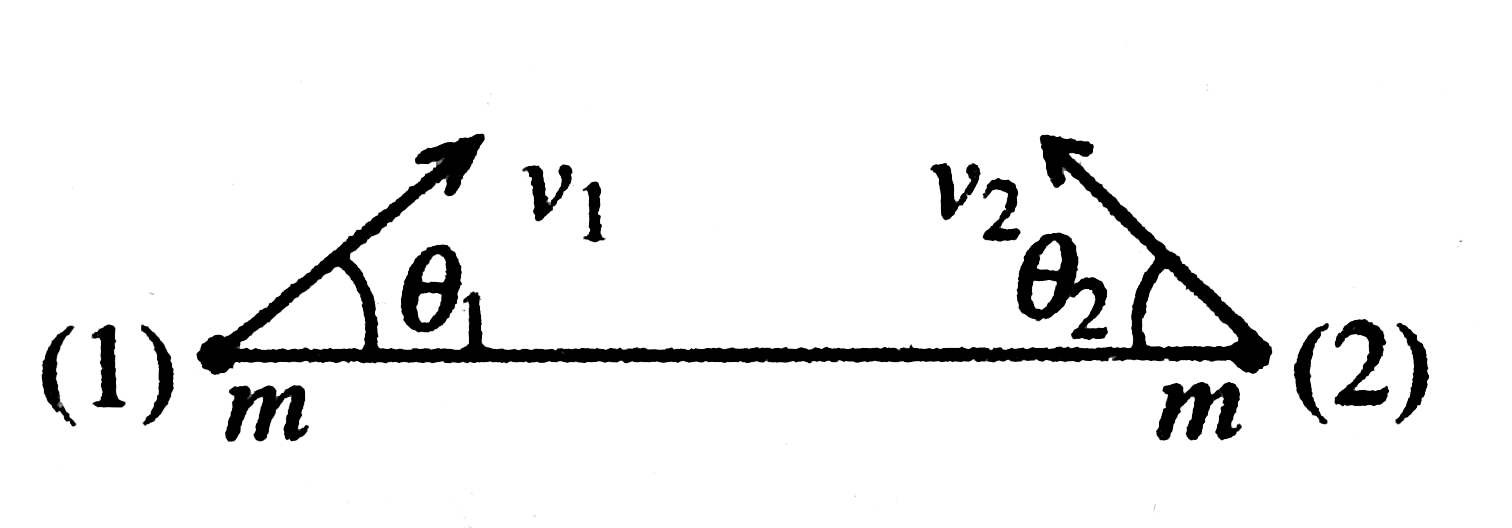Two particles are projected simultaneously in the same vertical plane from the same point, with different speeds u1 and u2, making angles θ1 and θ2 respectively with the horizontal, such that u1cosθ1=u2cosθ2. The path followed by one, as seen by the other (as long as both are in flight), is
a vertical line
a parabola
a hyperbola
a straight line making a constant angle (≠90∘) with horizontal
The correct Answer is:D
To solve the problem, we need to analyze the motion of two particles projected simultaneously from the same point with different speeds and angles. The key condition given is that the horizontal components of their velocities are equal.
1. Identify the Given Information:
- Two particles are projected with speeds u1 and u2.
- They make angles θ1 and θ2 with the horizontal.
- The condition given is u1cosθ1=u2cosθ2.
2. Determine the Velocity Components:
- For Particle 1:
- Horizontal velocity: v1x=u1cosθ1
- Vertical velocity: v1y=u1sinθ1−gt
- For Particle 2:
- Horizontal velocity: v2x=u2cosθ2
- Vertical velocity: v2y=u2sinθ2−gt
3. Use the Given Condition:
- Since u1cosθ1=u2cosθ2, we can denote this common horizontal velocity as vx. Thus, both particles have the same horizontal velocity.
4. Calculate the Relative Velocity:
- The relative velocity of Particle 1 with respect to Particle 2 is given by:
vrel=v1−v2
- This results in:
vrel,x=v1x−v2x=0(since they have the same horizontal component)
- For the vertical component:
vrel,y=v1y−v2y=(u1sinθ1−gt)−(u2sinθ2−gt)=u1sinθ1−u2sinθ2
5. Analyze the Path:
- The relative vertical velocity vrel,y=u1sinθ1−u2sinθ2 is a constant (since u1 and u2 are constants).
- Since the horizontal component of the relative velocity is zero, the motion of one particle as seen from the other will be purely vertical.
6. Conclusion:
- The path followed by one particle as seen by the other is a straight line making a constant angle with the horizontal (not equal to 90 degrees).
Final Answer:
The path followed by one particle as seen by the other is a straight line making a constant angle not equal to 90 degrees with the horizontal.
---
- Two particles are projected with speeds u1 and u2.
- They make angles θ1 and θ2 with the horizontal.
- The condition given is u1cosθ1=u2cosθ2.
- For Particle 1:
- Horizontal velocity: v1x=u1cosθ1
- Vertical velocity: v1y=u1sinθ1−gt
- For Particle 2:
- Horizontal velocity: v2x=u2cosθ2
- Vertical velocity: v2y=u2sinθ2−gt
- Since u1cosθ1=u2cosθ2, we can denote this common horizontal velocity as vx. Thus, both particles have the same horizontal velocity.
- The relative velocity of Particle 1 with respect to Particle 2 is given by:
vrel=v1−v2
- This results in:
vrel,x=v1x−v2x=0(since they have the same horizontal component)
- For the vertical component:
vrel,y=v1y−v2y=(u1sinθ1−gt)−(u2sinθ2−gt)=u1sinθ1−u2sinθ2
- The relative vertical velocity vrel,y=u1sinθ1−u2sinθ2 is a constant (since u1 and u2 are constants).
- Since the horizontal component of the relative velocity is zero, the motion of one particle as seen from the other will be purely vertical.
- The path followed by one particle as seen by the other is a straight line making a constant angle with the horizontal (not equal to 90 degrees).
The path followed by one particle as seen by the other is a straight line making a constant angle not equal to 90 degrees with the horizontal.
Topper's Solved these Questions
- MOTION IN A PLANE BOOK - NCERT FINGERTPS ENGLISHCHAPTER - MOTION IN A PLANE EXERCISE - HOTS
6 Videos
- MOTION IN A PLANE BOOK - NCERT FINGERTPS ENGLISHCHAPTER - MOTION IN A PLANE EXERCISE - EXEMPLER PROBLEMS
9 Videos
- MECHANICAL PROPERTIES OF SOLIDSBOOK - NCERT FINGERTPS ENGLISHCHAPTER - MECHANICAL PROPERTIES OF SOLIDSEXERCISE - Assertion And Reason
15 Videos
- MOTION IN A STRAIGHT LINEBOOK - NCERT FINGERTPS ENGLISHCHAPTER - MOTION IN A STRAIGHT LINEEXERCISE - NCERT Exemplar
6 Videos
Similar Questions
Two particles are projected simultaneously in the same vertical plane, with speed u1 and u2 at angle of projection θ1 and θ2 respectively with the horizontal. The path followed by one, as seen by other (as long as both are in flight), is
View SolutionTwo projectiles are thrown simultaneously in the same plane from the same point. If their velocities are v1 and v2 at angles θ1 and θ2 respectively from the horizontal, then ansewer the following questions
The trajectory of particle 1 with respect to particle 2 wil be
View SolutionA particle is projected at an angle θ with an initial speed u.
View SolutionTwo particles of equal mass in are projected from the ground with speeds v1 and v2 at angles θ1, and θ2 as shown in the figure. Given θ2>θ1 and v1cosθ1=v2cosθ2Which statement/s is/are correct?

View SolutionTwo particles of equal mass 'm' are projected from the ground with speed v1 and v2 at angles θ1 and θ2 at the same times as shown in figure. The centre of mass of the two particles.

View SolutionThe locus of the point of intersection of two tangents to the parabola y2=4ax which make the angles θ1 and θ2 with the axis so that cot θ1+cotθ2 = k is
View SolutionThe locus of the point of intersection of two tangents to the parabola y2=4ax which make the angles θ1 and θ2 with the axis so that cot θ1+cotθ2 = c is
View SolutionThe molecular velocities of two gases at same temperature are u1 and u2, their masses are m1 and m2 respectively, which of the following expression is correct ?
View SolutionThe molecular velocities of two gases at same temperature are u1 and u2, their masses are m1 and m2 respectively, which of the following expression is correct ?
View SolutionTwo particles are projected from the same point with the same speed at different angles θ1 & θ2 to the horizontal. They have the same range. Their times of flight are t1 & t2 respectily
View Solution
